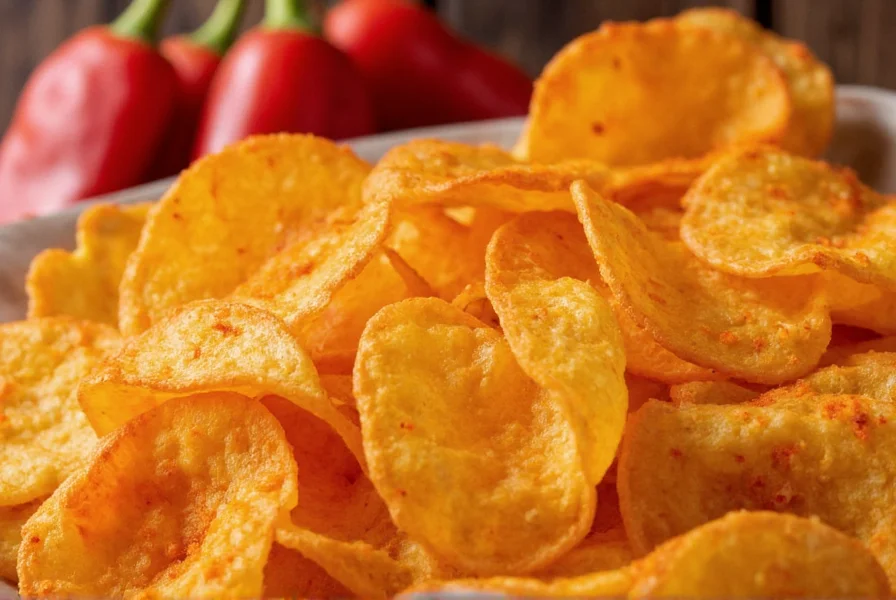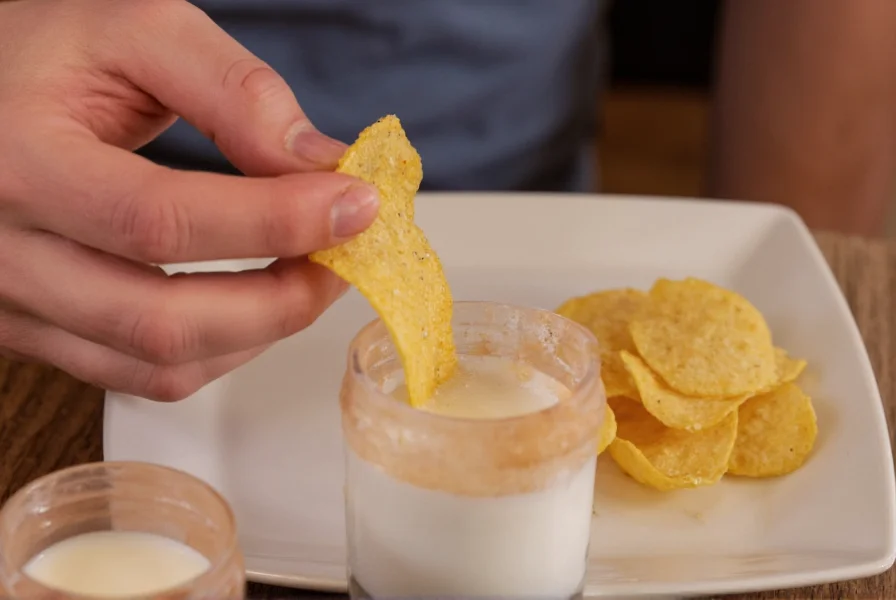Ghost pepper chips represent the frontier of extreme snack foods, challenging even seasoned spice enthusiasts with their formidable heat. Unlike regular spicy snacks, these chips incorporate Bhut Jolokia peppers—once recognized as the world's hottest chili—which originated in Northeast India and were officially measured at over 1 million Scoville Heat Units (SHU) by Guinness World Records in 2007. When processed into chips, the heat typically ranges between 200,000-500,000 SHU, substantially hotter than jalapeño peppers (2,500-8,000 SHU) or even habanero peppers (100,000-350,000 SHU).
The Science Behind the Scorch: Understanding Ghost Pepper Heat
The intense heat in ghost pepper chips comes from capsaicinoids, particularly capsaicin and dihydrocapsaicin, concentrated compounds found in the pepper's placenta and seeds. When you consume these chips, capsaicin binds to TRPV1 receptors in your mouth and throat, triggering a neurological response that your brain interprets as burning heat. This reaction isn't actual tissue damage but rather a chemical illusion that can cause sweating, flushing, and increased heart rate.
What makes ghost pepper chips particularly challenging is their heat progression. Unlike milder spicy snacks that deliver immediate but short-lived heat, ghost pepper varieties follow a distinctive pattern:
| Time After Consumption | Physical Sensation | Recommended Action |
|---|---|---|
| 0-30 seconds | Mild initial heat, subtle smoky flavor | Enjoy the complex flavor profile |
| 30-90 seconds | Building warmth spreading across tongue | Prepare for intensifying heat |
| 90-180 seconds | Intense burning sensation, possible sweating | Have dairy products ready |
| 3-5 minutes | Peak heat experience, possible facial flushing | Avoid drinking water; use milk instead |
| 5-15 minutes | Gradual subsiding of heat, lingering flavor | Recovery period begins |
Production Process: From Farm to Fiery Snack
Creating ghost pepper chips requires careful handling at every stage. Manufacturers typically use one of two approaches: incorporating ghost pepper powder directly into the chip seasoning blend or infusing the cooking oil with ghost pepper extracts. The powder method allows for more consistent heat distribution, while oil infusion creates a more gradual heat release.
Quality ghost pepper chips maintain a balance between extreme heat and actual flavor. The best varieties showcase the ghost pepper's complex profile—initially sweet and fruity with notes of woodsmoke—before the intense heat emerges. Lower quality products often rely solely on the heat factor without developing the pepper's nuanced flavor characteristics.

Safety Considerations for Extreme Heat Snacks
Consuming ghost pepper chips requires awareness of potential physical reactions. The capsaicin concentration can cause:
- Temporary esophageal irritation
- Increased salivation and sweating
- Elevated heart rate (typically 10-20 BPM increase)
- Facial flushing and possible hiccups
Certain individuals should avoid ghost pepper chips entirely, including those with gastrointestinal conditions like IBS or ulcers, people taking certain medications that interact with capsaicin, and children under 12. If you decide to try them, start with a single chip and wait at least 15 minutes before consuming more to assess your tolerance.
Managing the Heat: Practical Consumption Strategies
Seasoned spice enthusiasts recommend several techniques for handling ghost pepper chips:
- Pair with dairy: Full-fat yogurt, sour cream, or milk effectively neutralize capsaicin through casein proteins
- Avoid water: Water spreads capsaicin rather than dissolving it, potentially worsening the burning sensation
- Start small: Begin with a fraction of one chip to gauge your tolerance before proceeding
- Have sugar ready: A small amount of sugar can help counteract the heat by binding to capsaicin
- Build tolerance gradually: Regular exposure to moderate spicy foods can increase your heat tolerance over time
For those seeking an authentic ghost pepper chip experience without overwhelming heat, look for products that combine ghost peppers with complementary flavors like mango, lime, or smoked paprika, which can balance the extreme spiciness with contrasting taste elements.
Nutritional Profile and Health Implications
Ghost pepper chips maintain a similar nutritional profile to standard potato chips but with added capsaicin benefits. A typical one-ounce serving contains:
- 150-160 calories
- 10g fat (mostly from cooking oil)
- 15g carbohydrates
- 1-2g protein
- Significant capsaicin content (varies by brand)
Capsaicin offers several potential health benefits, including temporary metabolism boost, pain relief properties, and anti-inflammatory effects. However, the concentration in ghost pepper chips is primarily for flavor rather than therapeutic benefit. Consuming them in excess can lead to gastrointestinal distress, so moderation remains key even for spice-tolerant individuals.

Finding Your Heat Tolerance Threshold
Determining whether you can handle ghost pepper chips involves understanding your personal heat tolerance. Consider these factors before taking the plunge:
- Your experience with other spicy foods (habanero, scorpion pepper products)
- Previous reactions to extremely spicy challenges
- Current health conditions that might be exacerbated by capsaicin
- Whether you have appropriate heat-relief options available
Many enthusiasts recommend building up to ghost pepper chips by first trying milder superhot varieties like habanero or cayenne-based snacks. This gradual approach allows your TRPV1 receptors to adapt, making the ghost pepper experience more enjoyable and less overwhelming.
Ghost Pepper Chips vs. Other Superhot Snacks
When exploring extreme heat snacks, understanding how ghost pepper chips compare to alternatives helps set proper expectations:
- Ghost vs. Scorpion Pepper Chips: Scorpion peppers (1,200,000-2,000,000 SHU) deliver a sharper, more immediate heat than ghost peppers' building burn
- Ghost vs. Carolina Reaper Chips: Reaper varieties (1,400,000-2,200,000 SHU) offer more intense heat with fruity undertones compared to ghost's smokier profile
- Ghost vs. Standard Hot Chips: Traditional hot nacho cheese or jalapeño chips (1,000-10,000 SHU) provide mild heat without the delayed intensity of ghost varieties
The unique appeal of ghost pepper chips lies in their flavor complexity that emerges after the initial heat subsides—a characteristic many superhot enthusiasts appreciate beyond mere heat measurement.
Frequently Asked Questions About Ghost Pepper Chips
How hot are ghost pepper chips compared to regular spicy chips?
Ghost pepper chips typically measure between 200,000-500,000 Scoville Heat Units, making them 20-50 times hotter than standard jalapeño-flavored chips (5,000-10,000 SHU) and noticeably hotter than habanero chips (100,000-300,000 SHU). The heat builds gradually rather than hitting immediately.
What should I do if ghost pepper chips are too spicy?
If ghost pepper chips become uncomfortably spicy, consume full-fat dairy products like milk or yogurt rather than water. The casein in dairy binds to capsaicin and helps remove it from pain receptors. Sugar or honey can also provide temporary relief by counteracting the heat sensation.
Can eating ghost pepper chips be dangerous?
While ghost pepper chips aren't dangerous for most healthy adults when consumed in moderation, they can cause significant discomfort including sweating, flushing, and gastrointestinal distress. Individuals with ulcers, IBS, or other digestive conditions should avoid them, as the capsaicin can exacerbate these conditions.
Do ghost pepper chips have any health benefits?
The capsaicin in ghost pepper chips may offer temporary metabolism boost and pain relief properties. However, the concentration in snack chips is primarily for flavor rather than therapeutic benefit. Like regular chips, they should be consumed in moderation as part of a balanced diet due to their fat and sodium content.
How can I build tolerance to eat ghost pepper chips?
Building tolerance to ghost pepper chips requires gradual exposure. Start with milder spicy foods like jalapeños, then progress to habaneros before attempting ghost peppers. Regular consumption of moderately spicy foods can increase your heat tolerance over time as your TRPV1 receptors adapt to capsaicin exposure.











 浙公网安备
33010002000092号
浙公网安备
33010002000092号 浙B2-20120091-4
浙B2-20120091-4